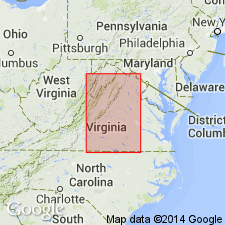
- Usage in publication:
-
- Manassas sandstone
- Modifications:
-
- Named
- Dominant lithology:
-
- Sandstone
- AAPG geologic province:
-
- Piedmont-Blue Ridge province
- Culpeper basin
Summary:
Red, gray, and yellow sandstone exposed near Manassas, Prince William Co., Va., is here named the Manassas Sandstone. It has been referred to as the New Red sandstone, Triassic brownstone, and Newark sandstone, and is the same red sandstone as that found in the Connecticut Valley, New Jersey, Pennsylvania, and Maryland. It here extends in broken belts from south of the Potomac River to the Carolina border. It overlies older crystalline rocks and the Border Conglomerate and underlies the Bull Run Shales. Age is Triassic.
Source: GNU records (USGS DDS-6; Reston GNULEX).
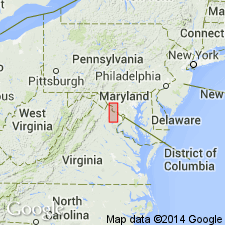
- Usage in publication:
-
- Manassas Sandstone*
- Modifications:
-
- Revised
- AAPG geologic province:
-
- Piedmont-Blue Ridge province
- Culpeper basin
Summary:
The Manassas Sandstone is here assigned to the Newark Group and divided into the lower Reston Member, a fluvial wash conglomerate fan deposit, which grades into and intertongues with the upper sandstone member, which forms the bulk of the unit.
Source: GNU records (USGS DDS-6; Reston GNULEX).
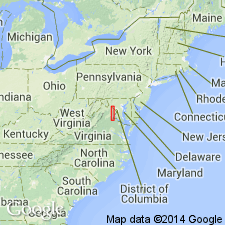
- Usage in publication:
-
- Manassas Sandstone
- Modifications:
-
- Revised
- AAPG geologic province:
-
- Piedmont-Blue Ridge province
- Culpeper basin
Summary:
The Manassas Sandstone is here assigned to the Culpeper Group and, following the usage of Roberts (1928), is revised as the sequence dominated by sandstone which gradationally overlies the revised Reston Formation and gradationally underlies the Bull Run Formation. It crops out in the eastern part of the Culpeper basin north of the Rappahannock River. Maximum thickness is from 800 to 900 m (2,700 to 3,000 ft).
Source: GNU records (USGS DDS-6; Reston GNULEX).
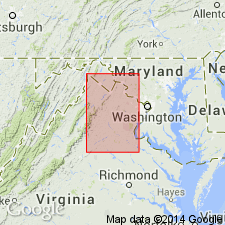
- Usage in publication:
-
- Manassas Sandstone*
- Modifications:
-
- Revised
- Biostratigraphic dating
- AAPG geologic province:
-
- Piedmont-Blue Ridge province
- Culpeper basin
- Barboursville basin
Summary:
The Manassas Sandstone of the Culpeper Group is here revised to include four members. The three lower members are discrete and separate lenticular conglomerate units, described as units of the Border Conglomerate by Roberts (1928). These are the Rapidan Member in the Barboursville basin and southeastern part of the Culpeper basin, the Reston Member in the east-central part of the Culpeper basin, and the Tuscarora Creek Member in the northern part of the Culpeper basin. Each member unconformably overlies or is in fault contact with pre-Triassic crystalline rocks and each grades into or interfingers with the overlying Poolesville Member. Thickness is 200 to 1,030 m (650 to 3,350 ft). Age is late Carnian to possibly middle Norian based on spores and plant fossils. The Manassas may be time transgressive.
Source: GNU records (USGS DDS-6; Reston GNULEX).
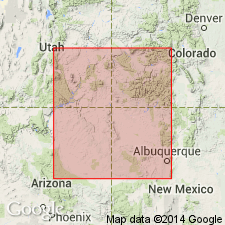
- Usage in publication:
-
- Manassas Sandstone*
- Modifications:
-
- Age modified
- Biostratigraphic dating
- AAPG geologic province:
-
- Piedmont-Blue Ridge province
- Barboursville basin
- Culpeper basin
Summary:
The age of the Manassas Sandstone in the Culpeper basin is changed to late Carnian and early Norian based on palynology. The upper part of the Manassas is extended into the Norian. The lower part of the formation is difficult to date.
Source: GNU records (USGS DDS-6; Reston GNULEX).
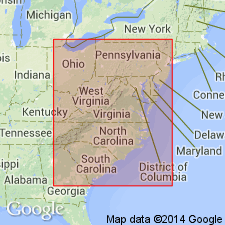
- Usage in publication:
-
- Manassas Sandstone*
- Modifications:
-
- Biostratigraphic dating
- AAPG geologic province:
-
- Piedmont-Blue Ridge province
Summary:
A new palynomorph species, FROELICHSPORITES TRAVERSEI, occurs throughout Newark Supergroup of eastern United States and Canada, Dockum Group of TX and NM, and Chinle Formation of NM, AZ, and UT. It is restricted geologically to strata deposited during upper Carnian and Norian Stages of the Upper Triassic. It occurs in the following formations of the Newark Supergroup: Passaic Formation (NJ), Gettysburg Formation (PA and MD), Manassas Sandstone (MD), Balls Bluff Siltstone (VA), Cow Branch Formation (NC), and Stoneville Formation (NC).
Source: GNU records (USGS DDS-6; Reston GNULEX).
For more information, please contact Nancy Stamm, Geologic Names Committee Secretary.
Asterisk (*) indicates published by U.S. Geological Survey authors.
"No current usage" (†) implies that a name has been abandoned or has fallen into disuse. Former usage and, if known, replacement name given in parentheses ( ).
Slash (/) indicates name conflicts with nomenclatural guidelines (CSN, 1933; ACSN, 1961, 1970; NACSN, 1983, 2005, 2021). May be explained within brackets ([ ]).

